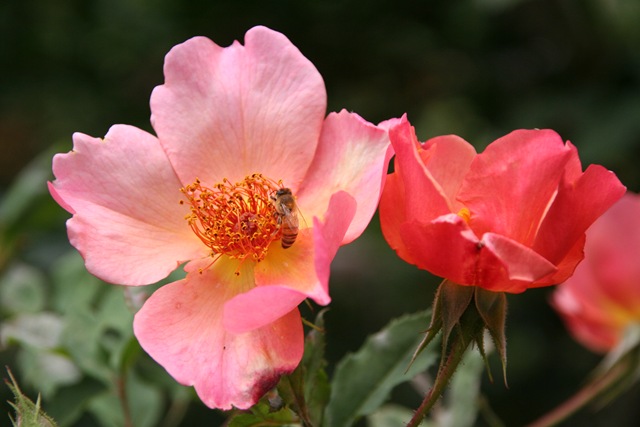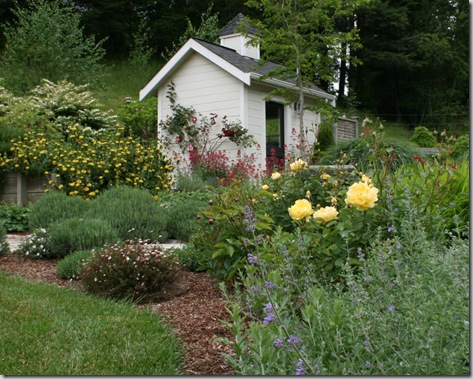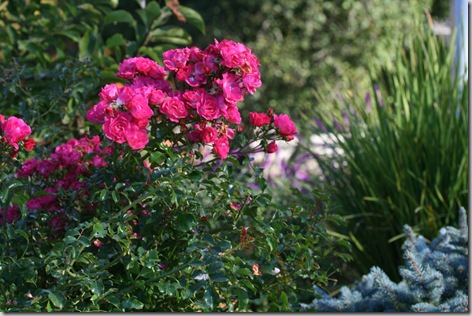
As a professional gardener, my philosophy leans more towards making organic and sustainable choices in the garden, not only because I’m afraid of what long-term repeated exposure could do to my health, but also because I have the power to help so many people make better choices for their gardens.
The organic philosophy can be difficult to keep up, however, in the face of over-bred plants like many Hybrid Tea roses. Don’t get me wrong, I love roses! But so many have been bred aggressively for just the blooms, and often breeders of Hybrid Tea roses have ignored factors such as sturdiness and disease-resistance.
If you’d like to grow roses organically in the often-damp climate of the coastal Pacific Northwest, here are some varieties which are resistant to disease in moist/ humid climates:
Cut-flower roses to bring indoors:
Who doesn’t love a bouquet of fresh roses? Most disease-resistant varieties make poor cut flowers, but I’ve tried a number of roses in my clients’ gardens here in the damp Redwoods of Northern California, and these cut-flower roses do great here.
David Austins are bred in England, so they’re used to fog, rain and moist air. I usually recommend roses with as low of a petal count as you can find (below 35 is best), since more petals equals more places to trap moisture, and moisture equals fungus, but because of where and how they were bred, many of the ruffly Austin roses do great here.
‘Carding Mill’ is a ruffly apricot bloomer with a myrrh fragrance.
‘Heritage’ – follow the link to see a photo of these pale pink roses in a vase. They only last a few days, but look gorgeous while they’re there!
‘Queen of Sweden’ is a cupped, pretty pink rose with a light myrrh fragrance.
‘Benjamin Britten’ is a brilliant red with great fragrance, and is vigorous enough it can be grown as a climber or a shrub.
Other good cut-flower roses:
‘Europeana’ Ever taken a photo of a red so bright it blurred out the picture? Yeah, this is that color. Wear sunglasses before clicking the link.
‘Just Joey’, a fragrant apricot-orange that rosarians swear by.
‘Bonica’ or ‘Royal Bonica’, both delicate-looking pink beauties with a light sweet fragrance.
‘Hot Cocoa’ is kind of a crazy color – I wouldn’t call it chocolate color, really – it’s more of an orangey-bronzey-reddish brick-like color. Makes great cut flowers.
‘Burgundy Iceberg’, a vivid thornless beauty (perfect for you goth gardeners!).
‘Julia Child’ is a small but very fragrant yellow shrub.
‘Sexy Rexy’, with pale pink Camellia-like blooms.
Colorful, heavy bloomers for the landscape:
Sometimes our best success comes from deciding to enjoy our roses outside, and choosing varieties that have been bred specifically for sturdiness in the garden. Many of these make terrible cut flowers; either the petals explode in a great mess when you cut them, or the flowers only last a day – but all the roses listed here will make gorgeous flowers for enjoying outdoors in the garden, and are among the sturdiest roses available.
Rugosa roses are tough roses with textured, quilted leaves different from the glossy leaves we expect on so many roses. They also have loads of tiny prickles all along each stem, but I actually find their prickles less offensive than those of most roses, because they are so small and profuse that they don’t usually pierce the skin.
This is the only rose I’d say even comes close to deer-resistance, and there are so many nice varieties. They also produce rose hips, which you can use to make jam if you grow your roses organically!
Some varieties spread slowly by suckers/ new shoots and will make new plants for you in the garden, so if you object to that (or have landscape fabric that will get pushed up by suckers), make sure you get a variety that growers euphemistically call “neat” or “tidy” in its habit.
I’ve never seen a Rugosa with any pest or disease, period.
Try these Rugosas:
‘Buffalo Gal’, a pinky-purple rugosa that has not been touched by the deer in a garden where every other rose has been chomped multiple times, despite being sprayed by deer repellent and guarded (usually) by a Scarecrow sprinkler.
‘Topaz Jewel’ flowers like mad and is a pretty double yellow. Many Pacific Northwest rose fans swear by ‘Topaz’.
‘Blanc Double De Coubert’ is a reliable double white with a neat habit (see? Less suckery!).
Other great landscape roses:
Knockout roses get rave reviews from everyone and are especially good in hotter climes, though word is they perform well on the coast, too.
Flower Carpet Roses make a wonderful sprawling companion to lavenders and ornamental grasses – check out the new amber one.
‘Sally Holmes’ is one of my favorite shrubby roses, getting to 6’+ and blooming again and again through the year. Pale salmony-pinky-white single flowers.
‘Baby Love’ is a small yellow plant that I’ve never seen get even a whiff of black spot.
‘Happy Chappy’ – is a very pretty rose with sunset-like colors of yellow, orange and pink. It keeps selling out at my local nurseries – as soon as they get them in, whether in 4” size or 5-gallons – people fall in love and take them home.
‘Gourmet Popcorn’ is a lovely small rose with little popcorns of white and yellow.
‘The Fairy’ is a petite thing in bubblegum pink. It gets to about 2-3’ tall and is a classic mini rose.
‘Mary Rose’ is a very nice fragrant pink.
‘Nearly Wild’ is a very fragrant old-fashioned single-petaled rose in a dusky pink.
Disease-resistant climbing roses:
‘Constance Spry’ – a loose, openly growing shrubby climber to about 6’ tall, the fragrance is like myrrh and the petals are a pale pink (a David Austin rose).
‘Graham Thomas’ – a bright ruffly yellow climber to 5-10’, this is a very fragrant rose (David Austin).
‘Climbing Iceberg’, a simple white climber with a good cut flower but little fragrance.
‘Lady Banks Rose’, in yellow or white, these thornless old-fashioned climbers have profuse clusters of tiny flowers. Give her some room to grow, she’ll get 15-20’ tall and will cover a pergola nicely.
‘Cecile Brunner’, of course – the usual suspect in old-fashioned gardens, she’s a super vigorous light pink climber to 25’ plus. Thorny but fragrant.
I hope this list of disease-resistant roses for the coastal Pacific Northwest is helpful to you! Of course, you’ll want to prevent rose pests with good care, even with disease-resistant varieties. If you do end up with rose pests, check out this article on controlling rose pests organically. Click here to learn how to select bare root roses.
What are your favorite disease-resistant roses? Let me know in the comments below!



19 responses to “Disease-Resistant Roses for the Pacific Northwest”
I admit that the thing I disliked about working as a gardener was that some clients INSISTED on using products I don’t personally use. I got to the point where I’d ask about that before accepting new clients, because I just felt so wrong doing it! I’m not a big rose person, but love the singles and the easier-care kind.
Hi, I live in Brookings-Harbor, Oregon, on a usually breezy and often windy bluff overlooking the ocean. I’d like to plant three roses in pots on my deck (management won’t allow planting in the ground). Are all of these northwest-recommended roses tolerant of near-constant breeze/wind? (I love Chrysler Imperial, Double Delight, Just Joey, Happy Chappy, Knockout, Sunset, and all David Austins.)
What a great post. For me Ive had great luck in the Seattle area with:
-Madame Alfred Carriere — a noisette rose, pinkish white, cllimber,fragrant
-Sombreuil – gorgeous white fragrant confection, frgrant
-Don Juan — red climber, fragrant and reliable
-Francois Juranville — big rambler, thornless, once blooming but gorgeous
Happy growing,
Tom
.-= tom | tall clover farm´s last blog ..Tomato Plants: Leave the Little Suckers Alone =-.
You are so right Monica, I’m with you. I won’t use the non-organic snail bait and if clients use it profusely I just won’t work around it – they can clean up their own flowerbeds if they want to use something that toxic.
Tom, thank you so much for the awesome list of your own! I’ve actually tried Sombreuil too and had good luck with it. It really is a pretty thing.
Ok, roses that love our cool coastal climate. Yes, many of the Austins are great, some other Austins I have had good luck with are Leander, A Shropshire Lad, Golden Celebration, Brother Cadfael, Mary Rose, Abraham Darby, Othello and there are more…oh yes Pat Austin. The hybrid musks are excellent…Kathleen a real favorite, Trier, Buff Beauty, Lavender Lassie, Cornelia and there are more. The Austins almost all make good cut roses. The old European varieties are what I plant in my worst spots…damp…not so much sun etc. The albas are fragrant and wonderful, gallicas tough as nails and fragrant too and a few Damasks like Ispahan can take our damp. Lots of great climbers. Dortmund, the large musk type ramblers, some like Albertine people love, but they can be funky after the big bloom, and The Noisettes are an interesting class of roses that rebloom. They are from the 19th century and are mostly light colored…Mme Alfred Carriere we see alot around here in old plantings. Lamarque, Reve d’Or, Narrow Water are some more. So many good ones….why why why plant chemical dependent sad roses??
OK Cindy, Clearly you and I have got to get together for some photo-taking and interviews here, because man oh man are you a wealth of great knowledge. Thank you so much for your wonderful input. Once again, printing out and taking copious notes!!
What hardy climbing roses would you recomend for living on the coast in Florence, OR. It would be planted on a trellis where it would get morning/early afternoon sun and late afternoon shade from a tall old pine tree. I have grown Hybred rose bushes but have almot given up due to black spot, I treat them but to no avail. I gave them away to my son who lives in Albany OR. where he get much more sun than I do where I planted them. I have some in pots on the deck and they do better but not as well as the first couple years after planting them. So I need the hardest of climbers.
Thank you,
Jean Caroline… I love roses.
Here are what they looked like for a couple years. I only have a few left.. sad.
http://picasaweb.google.com/CarolineGardens/TheBeautifulRose02?authkey=Gv1sRgCOu34MSrqYHLbw#
Hi Jean Caroline, I would not recommend a rose in a spot that gets afternoon shade. They suffer too much from diseases and don’t bloom well. It might also suffer from acidic soil near a pine tree. You might try a climbing Hydrangea (H petiolaris) instead?
Your roses were just lovely. Great photos…
If you must use a rose I might try calling Regan Nursery (look for them online) during bare root season and asking for a recommendation. They sell them so could give you hints on what would work for you, and then could ship it to you.
I have to disagree with Genevieve. My roses are monsters at the back of my house, all in afternoon shade. 3-4 hrs. morning sun at the most. No diseases. I find that red roses burn in the afternoon sun. For those who may be interested, what I have growing is Westerland, Liebeszauber, Abraham Darby, Penelope, Freisinger Morgenrote. I have a Don Juan that is in 6 hrs. of sun, afternoon sun, simply not opening, and the buds are burning before it has a chance to open. So, I will be moving it. I am in zone 7. PNW.
Oh, we’re just in different climates, Elina, and differences in soil type and watering will have an effect on how any plant does. I would not recommend anyone on the coast plant roses in afternoon shade, but I am glad to know what’s working inland in a more extreme zone. Thanks for sharing what is working for you! I know that people will find it helpful on their own gardening journeys, especially since you were able to give your zone info.
I don’t understand the (Your comment is awaiting moderation.)
Jean Caroline, that just means that since you’ve never commented before, or maybe because you included a link, I got a special email asking me to review your comment before it showed up on the site. Nothing to worry about! I’ve seen you’re an actual human being, so we’re good! 🙂
There can hardly be any one who doesn’t love a bouquet of fresh roses. It is my favourite flower & i do have red, yellow and pink roses in my garden. Loved reading your post on this topic and looking forward to more like this.
[…] in our Maritime climate. Also, Genevieve Schmidt at North Coast Gardening has a great post on Disease-Resistant Roses for the Pacific Northwest. Hybrid Rosa rugosas are sturdy and disease resistant. Look for those with a “neat” or […]
Hi: I’ve just enjoyed your website immensely. I truly enjoy my “Blanc Double de Coubert”, and, being a proofreader, could not help seeing that there is a typo. I tried emailing the Regan Nursery but they don’t have an easy email response menu item. In your wonderful website you mention “Blanc Double de Courbet” whcn, actually, the “r” is just before the “t”. I’ll try to fax the Regan Nursery to see if they want to correct this. It’s a totally different pronunciation (as I am sure you are aware). I’m planning on visiting the nursery in the near future, perhaps I can let them know then. I, too, live in the Pacific Northwest. Is it not the most beautiful place in the world?!!!! (Well, I’m not that well travelled — how about in Northern California!) Thanks for reading. Luana
Thanks so much, Luana! I appreciate your letting me know. I’ve fixed that in my post, at least!
I think it is silly you are recommending the Lady Banks Rose. I have a five year old that has climbed higher than my house and has never bloomed. It’s got to go. I will replace it with something that will actually bloom. I hope.
The ones I have planted for clients are all blooming, Barb! I’d suspect something in the site or the care that is causing an issue with lack of bloom, rather than the variety of the plant itself. I would take a wild guess that unless you figure out what the issue is, you are probably wasting money buying a new rose. It might not bloom either. If it gets full sunshine and has good care (regular water/ fertilizer that is meant for bloom and is not high in nitrogen), I’d suggest a soil test to dial in the possible issue.
I grow ‘Eden’ Climbing roses. They are doing very well, very healthy and vigorous on their own root. I am in Mendocino County 3 miles inland, with fog moving in almost every evening and burning off in the moring. They are the only plants I water at midday. There is already to much water on the foliage from the fog. I baby them as far as soil goes and use mocha bat guano as their fertilizer. Very beautful and showy. This particular rose has a high petal count, but they are heavy and droop down so the fog does not affect the flowers badly. If they are grown as a climber and you view from below, very stunning.